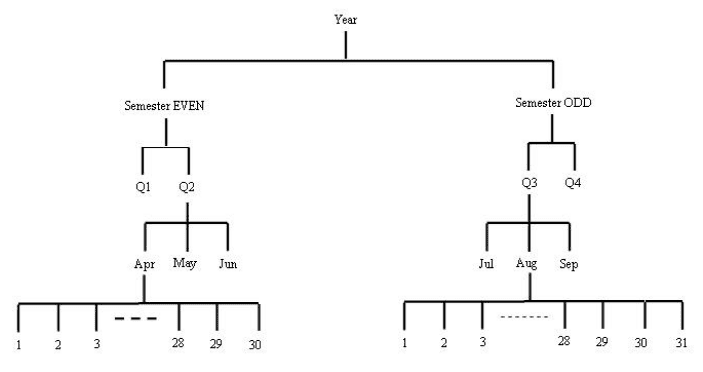
If you’re looking for Anaplan Interview Questions & Answers for Experienced or Freshers, you are in right place. There are a lot of opportunities from many reputed companies in the world. You still have the opportunity to move ahead in your career in Anaplan.Here ACTE sharing a very useful list of 50+ Anaplan questions. These real-time Anaplan interview questions will help you to crack your next Anaplan job interview. All the best for your future and happy Anaplan learning.
1. What is Anaplan, and how does it contribute to Time Management in business?
Ans:
- Anaplan is a cloud-based platform that facilitates business planning and performance management.
- In the context of time management, Anaplan allows organizations to model and analyze various temporal aspects, helping them create dynamic and flexible plans that adapt to changing business conditions.
- It provides a unified platform for time-based forecasting, budgeting, and scenario planning, promoting more accurate and timely decision-making.
2. How does Anaplan handle time granularity in its planning models?
Ans:
Anaplan supports multiple time granularities, from high-level annual planning to detailed daily forecasting. This flexibility allows organizations to model and analyze time-specific data at various levels of detail, ensuring that planning models align with the specific temporal requirements of different business processes.
3. What role does Time Series Analysis play in Anaplan’s forecasting capabilities?
Ans:
Anaplan leverages Time Series Analysis to examine historical data trends and patterns, providing valuable insights for forecasting future performance. This approach enhances the accuracy of predictions by considering historical time-based data, enabling organizations to make informed decisions based on past performance.
4. How does Anaplan support Rolling Forecasts, and what benefits does this feature offer?
Ans:
- Anaplan facilitates Rolling Forecasts by allowing organizations to continuously update and extend their forecasting horizon.
- This dynamic forecasting approach enables businesses to adapt to changing market conditions, incorporate new data, and maintain a forward-looking perspective, fostering agility and responsiveness in planning.
5. Explain the concept of Time-Phased Budgeting in Anaplan.
Ans:
Time-Phased Budgeting in Anaplan involves aligning budgeting activities with specific time periods. This ensures that budgeting processes are synchronized with business timelines, allowing organizations to allocate resources efficiently and track financial performance over distinct time intervals.
6. How does Anaplan support dynamic modeling and forecasting in business planning?
Ans:
| Aspect of Support | Description |
|---|---|
| Multidimensional Modeling | Anaplan enables dynamic modeling through its multidimensional data model. Users can create complex models with multiple dimensions, such as products, regions, and time periods. This flexibility allows for a detailed representation of business scenarios and relationships. |
| In-Memory Data Engine | Anaplan utilizes an in-memory data engine that stores data in RAM, enabling fast and real-time calculations. This feature contributes to the dynamic nature of models, ensuring that changes are instantly reflected, and users can perform complex calculations without delays. |
| Multidimensional Modeling | Anaplan enables dynamic modeling through its multidimensional data model. Users can create complex models with multiple dimensions, such as products, regions, and time periods. This flexibility allows for a detailed representation of business scenarios and relationships. |
| Real-Time Collaboration | Dynamic modeling is further enhanced by Anaplan’s real-time collaboration capabilities. Multiple users can work on the same model simultaneously, making updates and adjustments in real time. |
7. What is the significance of Time-Phased Planning in Anaplan?
Ans:
- Time-Phased Planning in Anaplan involves creating plans that unfold over specific time periods.
- This approach provides a detailed and structured framework for organizations to align their activities with business objectives, facilitating a more strategic and time-aware planning process.
8. How does Anaplan address the challenge of Time-Dependent Variables in forecasting models?
Ans:
Anaplan accommodates Time-Dependent Variables by allowing organizations to incorporate time-specific factors and variables into their forecasting models. This ensures that the impact of time-related elements is considered, enhancing the accuracy and reliability of predictions.
9. What functionalities is Anaplan’s Time-Phased Resource Allocation offering?
Ans:
Organizations may dynamically distribute resources over several time periods by utilizing Anaplan’s Time-Phased Resource Allocation capabilities. With the use of this skill, firms may manage their resources more effectively over time, making the most use of their staff, finances, and other assets.
10. How can Anaplan support Time-Phased Scenario Planning for organizations?
Ans:
- Anaplan helps with Time-Phased Scenario Planning by letting businesses build and examine a range of fictitious scenarios across certain periods of time.
- Businesses may use this skill to assess how various situations can affect their goals and make well-informed decisions to deal with obstacles in the road.
11. What is Time Intelligence in the context of Anaplan, and how does it enhance planning?
Ans:
- Time Intelligence in Anaplan refers to the platform’s ability to intelligently handle and analyze time-related data. It includes features like custom time hierarchies, time functions, and dynamic time-based calculations.
- This enhances planning accuracy by allowing organizations to model complex temporal scenarios and perform sophisticated analyses.
12. How does Anaplan integrate with external systems to handle Time-Phased Data Imports?
Ans:
Anaplan supports Time-Phased Data Imports by integrating with external systems through APIs and data connectors. This allows organizations to seamlessly import time-sensitive data from various sources, ensuring that their planning models are always up-to-date and reflective of the latest information.
13. What role does the Time-Weighted Average in Anaplan play in financial calculations?
Ans:
Time-Weighted Average in Anaplan is utilized for financial calculations that require considering the impact of time. It provides a mechanism to calculate averages while giving more weight to values occurring in specific time periods, offering a more accurate representation of financial performance over time.
14. How does Anaplan support Time-Phased Profitability Analysis?
Ans:
- Anaplan supports Time-Phased Profitability Analysis by allowing organizations to assess profit trends over specific time periods.
- This capability enables businesses to identify profitable periods, analyze contributing factors, and make strategic decisions to enhance overall profitability.
15. Explain the concept of Time Dimension Cross-Hierarchies in Anaplan.
Ans:
Time Dimension Cross-Hierarchies in Anaplan involve the ability to cross-reference and analyze data from different time hierarchies. This provides a holistic view of time-based information, allowing organizations to perform in-depth analyses across various time dimensions for comprehensive planning insights.

16. How does Anaplan handle Time-Based Forecast Adjustments?
Ans:
Anaplan allows organizations to make Time-Based Forecast Adjustments by providing tools for users to modify forecasts dynamically. This flexibility enables businesses to respond to changing market conditions, incorporating real-time insights into their forecasting models.
17. What advantages does Anaplan offer for Time-Phased Workforce Planning?
Ans:
- Anaplan’s Time-Phased Workforce Planning capabilities empower organizations to plan and manage their workforce efficiently over time.
- This includes forecasting staffing needs, optimizing resource allocation, and adapting workforce strategies to align with evolving business objectives.
18. How does Anaplan handle Time-Phased Cash Flow Analysis?
Ans:
Anaplan supports Time-Phased Cash Flow Analysis by allowing organizations to model and analyze cash flow trends over specific timeframes. This capability aids in optimizing cash flow management, ensuring businesses have the liquidity needed to meet financial obligations at different points in time.
19. Explain the role of Time Dimension Security in Anaplan.
Ans:
Time Dimension Security in Anaplan involves controlling access to time-based data based on user roles and permissions. This ensures that users can only view and modify data within specified time periods, enhancing data security and governance.
20. What is the significance of Time-Phased Project Planning in Anaplan?
Ans:
- Time-Phased Project Planning in Anaplan involves creating project timelines that unfold over specific time periods.
- This feature allows organizations to manage project resources, milestones, and dependencies, ensuring effective project execution and delivery within specified timeframes.
21. How does Anaplan handle Time-Phased Sales Forecasting for businesses?
Ans:
Anaplan supports Time-Phased Sales Forecasting by allowing organizations to model and analyze sales projections over specific time intervals. This capability aids in aligning sales strategies with market trends, enabling businesses to adjust their approach based on changing customer demands and economic conditions.
22. Can you explain the role of Time Dimension Annotations in Anaplan?
Ans:
- Time Dimension Annotations in Anaplan allow users to add contextual information to specific time periods.
- This feature enhances the understanding of time-based data, providing additional insights and details that contribute to more informed decision-making.
23. How does Anaplan handle Time-Phased Inventory Management?
Ans:
- Anaplan supports Time-Phased Inventory Management by allowing organizations to model and analyze inventory levels over specific timeframes.
- This capability aids in optimizing stock levels, ensuring that businesses maintain sufficient inventory to meet demand while avoiding excess holding costs.
24. What benefits does Anaplan’s Time-Phased Predictive Analytics offer for business planning?
Ans:
Anaplan’s Time-Phased Predictive Analytics leverages historical data to make predictions about future trends. This feature enhances forecasting accuracy by incorporating predictive insights into planning models, enabling organizations to proactively address potential challenges and opportunities.
25. Explain the role of Time-Phased Rolling Budgets in Anaplan.
Ans:
Time-Phased Rolling Budgets in Anaplan involve continuously updating budget projections to extend into future time periods. This dynamic budgeting approach ensures that organizations can adapt their financial plans to changing market conditions and evolving business strategies.
26. How does Anaplan handle Time-Phased Customer Relationship Management (CRM)?
Ans:
Anaplan’s Time-Phased CRM capabilities enable organizations to model and analyze customer-related activities and trends over specific timeframes. This feature supports businesses in tailoring their customer strategies to changing preferences and market dynamics.
27. What role does Time Dimension Customization play in Anaplan’s planning models?
Ans:
- Time Dimension Customization in Anaplan allows organizations to tailor time hierarchies based on their unique business needs.
- This flexibility ensures that planning models align precisely with the temporal requirements of different business processes, enhancing accuracy in analysis and forecasting.
28. How does Anaplan handle Time-Phased Capital Expenditure Planning?
Ans:
- Anaplan supports Time-Phased Capital Expenditure Planning by allowing organizations to model and analyze capital spending over specific time intervals.
- This capability aids in optimizing resource allocation, ensuring that capital investments align with business objectives and financial constraints.
29. Can you elaborate on Anaplan’s capabilities for Time-Phased Profit and Loss (P&L) Analysis?
Ans:
Anaplan’s Time-Phased Profit and Loss (P&L) Analysis feature allows organizations to model and analyze income and expenses over specific timeframes. This capability enhances financial visibility, enabling businesses to assess the profitability of different business segments and make strategic financial decisions.
30. How does Anaplan support Time-Phased Risk Management in business planning?
Ans:
- Anaplan facilitates Time-Phased Risk Management by allowing organizations to model and analyze potential risks over specific time periods.
- This capability enhances risk visibility, enabling businesses to implement proactive strategies for mitigating and responding to risks as they evolve.
31. What advantages does Anaplan’s Time-Phased Financial Consolidation offer for multinational organizations?
Ans:
Anaplan’s Time-Phased Financial Consolidation feature supports multinational organizations by allowing them to model and analyze financial data across different time zones and reporting periods. This capability ensures accurate and timely financial reporting, promoting compliance with regulatory requirements.
32. How does Anaplan handle Time-Phased Supplier Relationship Management (SRM)?
Ans:
Anaplan’s Time-Phased SRM capabilities enable organizations to model and analyze supplier-related activities and trends over specific timeframes. This feature supports businesses in optimizing their relationships with suppliers, ensuring efficient procurement and supply chain operations.
33. Explain the role of Time-Phased Employee Performance Management in Anaplan.
Ans:
- Anaplan supports Time-Phased Employee Performance Management by allowing organizations to model and analyze employee performance data over specific time intervals.
- This capability aids in aligning workforce strategies with business goals, fostering a culture of continuous improvement.
34. How does Anaplan address the challenge of Time-Phased Data Accuracy in planning models?
Ans:
Anaplan employs data validation mechanisms and audit trails to ensure the accuracy of time-based data in planning models. This feature enhances data integrity, providing organizations with confidence in the reliability of their time-phased planning and forecasting processes.
35. Can you elaborate on Anaplan’s features for Time-Phased Business Intelligence (BI)?
Ans:
Anaplan’s Time-Phased BI features allow organizations to integrate business intelligence into their planning models, providing real-time insights into performance trends over specific timeframes. This capability enhances decision-making by ensuring that planning processes are informed by the latest business intelligence data.
36. What role does Time-Phased Benchmarking play in Anaplan’s planning capabilities?
Ans:
- Anaplan supports Time-Phased Benchmarking by allowing organizations to compare their performance against industry benchmarks over specific time intervals.
- This feature provides valuable context for planning and decision-making, helping businesses identify areas for improvement and best practices.
37. How does Anaplan facilitate Time-Phased Asset Management for organizations?
Ans:
Anaplan’s Time-Phased Asset Management capabilities enable organizations to model and analyze the lifecycle of assets over specific timeframes. This feature supports businesses in optimizing asset utilization, maintenance schedules, and replacement strategies to align with evolving operational needs
38. Explain the role of Time-Phased Marketing Planning in Anaplan.
Ans:
Anaplan supports Time-Phased Marketing Planning by allowing organizations to model and analyze marketing activities and campaigns over specific time intervals. This capability enhances strategic marketing decision-making, ensuring that campaigns are executed with precision and timed for maximum impact.
39. How does Anaplan handle Time-Phased Financial Modeling for scenario analysis?
Ans:
- Anaplan’s Time-Phased Financial Modeling capabilities enable organizations to model and analyze financial scenarios over specific time periods.
- This feature supports businesses in conducting comprehensive scenario analysis, evaluating the impact of various factors on financial outcomes.
40. Can you explain the role of Time-Phased Cash Flow Forecasting in Anaplan?
Ans:
Anaplan’s Time-Phased Cash Flow Forecasting allows organizations to model and analyze cash flow projections over specific time intervals. This feature aids in optimizing liquidity management, ensuring businesses have the necessary funds to meet financial obligations and capitalize on strategic opportunities.
41. How does Anaplan handle Time-Phased Customer Segmentation for personalized strategies?
Ans:
Anaplan’s Time-Phased Customer Segmentation capabilities enable organizations to model and analyze customer segments over specific timeframes. This feature supports businesses in tailoring marketing and sales strategies to evolving customer preferences and behaviors.
42. Explain the role of Time-Phased Sustainability Planning in Anaplan.
Ans:
- Anaplan supports Time-Phased Sustainability Planning by allowing organizations to model and analyze sustainability initiatives over specific time intervals.
- This feature aids in aligning business strategies with environmental goals, ensuring a time-aware approach to sustainable practices.
43. How does Anaplan handle Time-Phased Regulatory Compliance in planning models?
Ans:
Anaplan incorporates Time-Phased Regulatory Compliance features to ensure that organizations can model and track compliance activities over specific timeframes. This capability supports businesses in meeting regulatory requirements and adapting their compliance strategies to changing legislative landscapes.
44. Can you elaborate on Anaplan’s Time-Phased Data Integration capabilities?
Ans:
- Anaplan’s Time-Phased Data Integration capabilities involve seamless integration with external systems to import time-sensitive data.
- This ensures that planning models are continuously updated with the latest information, enhancing the accuracy and relevance of time-phased analyses.
45. What role does Time-Phased Geographic Analysis play in Anaplan’s planning models?
Ans:
- Anaplan’s Time-Phased Geographic Analysis capabilities allow organizations to model and analyze business performance across different geographical regions over specific time intervals.
- This feature supports businesses in tailoring strategies to regional market trends and variations.
46. How does Anaplan address Time-Phased Currency Exchange Rates in multinational planning?
Ans:
Anaplan incorporates features for Time-Phased Currency Exchange Rates to support multinational organizations in modeling and analyzing financial data across different currencies over specific timeframes. This capability ensures accurate and consistent financial reporting in diverse global contexts.
47. Explain the role of Time-Phased E-commerce Planning in Anaplan.
Ans:
Anaplan supports Time-Phased E-commerce Planning by allowing organizations to model and analyze e-commerce activities over specific time intervals. This feature aids in optimizing online sales strategies, inventory management, and customer experiences based on evolving market dynamics.
48. How does Anaplan handle Time-Phased Predictive Maintenance Planning for assets?
Ans:
- Anaplan’s Time-Phased Predictive Maintenance Planning features enable organizations to model and analyze maintenance schedules for assets over specific timeframes.
- This capability supports businesses in optimizing maintenance activities, reducing downtime, and extending the lifespan of critical assets.
49. Can you elaborate on Anaplan’s features for Time-Phased Financial Risk Management?
Ans:
Anaplan’s Time-Phased Financial Risk Management features allow organizations to model and analyze financial risks over specific time intervals. This capability supports businesses in proactively identifying, assessing, and mitigating financial risks as they evolve.
50. How does Anaplan handle Time-Phased Supplier Performance Management?
Ans:
- Anaplan’s Time-Phased Supplier Performance Management features enable organizations to model and analyze supplier performance over specific timeframes.
- This capability supports businesses in optimizing supplier relationships, ensuring reliability, and mitigating risks associated with the supply chain.
51. What role does Time-Phased Healthcare Planning play in Anaplan’s capabilities?
Ans:
Anaplan supports Time-Phased Healthcare Planning by allowing organizations in the healthcare sector to model and analyze patient data, resource allocation, and treatment plans over specific time intervals. This feature aids in optimizing healthcare operations and ensuring quality patient care.
52. How does Anaplan handle Time-Phased Real Estate Portfolio Management?
Ans:
- Anaplan’s Time-Phased Real Estate Portfolio Management features enable organizations to model and analyze real estate assets over specific timeframes.
- This capability supports businesses in optimizing real estate investments, lease agreements, and property management strategies.
53. Can you elaborate on Anaplan’s features for Time-Phased Marketing Budgeting?
Ans:
Anaplan’s Time-Phased Marketing Budgeting features allow organizations to model and analyze marketing budgets over specific time intervals. This capability supports businesses in aligning marketing expenditures with strategic goals and adjusting budgets based on changing market conditions.
54. Explain the role of Time-Phased Quality Assurance Planning in Anaplan.
Ans:
- Anaplan supports Time-Phased Quality Assurance Planning by allowing organizations to model and analyze quality control processes over specific timeframes.
- This feature aids in optimizing product quality, ensuring compliance with standards, and adapting quality assurance strategies to changing requirements.
55. How does Anaplan address the challenge of Time-Phased Data Governance in planning models?
Ans:
Anaplan incorporates Time-Phased Data Governance features to ensure that organizations can manage and control data quality over specific timeframes. This capability supports businesses in maintaining data accuracy, integrity, and security throughout the planning process.
56. What advantages does Anaplan offer for Time-Phased Retail Merchandising Planning?
Ans:
- Anaplan’s Time-Phased Retail Merchandising Planning features enable organizations in the retail sector to model and analyze merchandise planning, inventory turnover, and sales forecasts over specific time intervals.
- This capability supports businesses in adapting retail strategies to changing consumer trends.
57. Can you explain how Anaplan handles Time-Phased Technology Roadmap Planning?
Ans:
Anaplan supports Time-Phased Technology Roadmap Planning by allowing organizations to model and analyze technology investments, development timelines, and innovation strategies over specific timeframes. This feature aids in aligning technology initiatives with business goals and adapting plans based on emerging trends.
58. What role does Time-Phased Corporate Social Responsibility (CSR) Planning play in Anaplan?
Ans:
- Anaplan supports Time-Phased Corporate Social Responsibility (CSR) Planning by allowing organizations to model and analyze CSR initiatives, environmental impact, and community engagement strategies over specific time intervals.
- This capability aids in aligning CSR efforts with business values and adjusting plans based on evolving social responsibilities.
59. How does Anaplan facilitate Time-Phased Training and Development Planning for human resources?
Ans:
Anaplan’s Time-Phased Training and Development Planning features enable organizations to model and analyze employee training programs, skill development, and workforce learning initiatives over specific timeframes. This capability supports businesses in aligning training strategies with evolving skill requirements and business objectives.
60. What is the role of Time-Phased Supply Chain Optimization in Anaplan?
Ans:
Anaplan supports Time-Phased Supply Chain Optimization by allowing organizations to model and analyze supply chain processes, inventory management, and demand forecasting over specific time intervals. This feature aids in adapting supply chain strategies to changing market conditions and optimizing overall operational efficiency.
61. How does Anaplan handle Time-Phased Transportation Planning for logistics?
Ans:
Anaplan’s Time-Phased Transportation Planning features enable organizations to model and analyze transportation schedules, route optimization, and logistics strategies over specific timeframes. This capability supports businesses in adapting transportation plans to fluctuating demand and operational requirements.
62. Can you elaborate on Anaplan’s Time-Phased Financial Close and Reporting capabilities?
Ans:
- Anaplan’s Time-Phased Financial Close and Reporting features allow organizations to model and analyze financial closing processes, reporting timelines, and compliance requirements over specific time intervals.
- This capability ensures timely and accurate financial reporting aligned with regulatory standards.
63. What role does Time-Phased Artificial Intelligence (AI) Integration play in Anaplan?
Ans:
Anaplan supports Time-Phased AI Integration by allowing organizations to integrate artificial intelligence algorithms into their planning models. This feature enhances predictive analytics, forecasting accuracy, and decision-making by leveraging AI capabilities over specific timeframes.
64. How does Anaplan handle Time-Phased Product Lifecycle Management (PLM)?
Ans:
- Anaplan’s Time-Phased Product Lifecycle Management features enable organizations to model and analyze product development timelines, launch strategies, and end-of-life planning over specific time intervals.
- This capability supports businesses in optimizing product lifecycles and adapting strategies based on market dynamics.
65. What advantages does Anaplan offer for Time-Phased Energy Consumption Planning?
Ans:
Anaplan’s Time-Phased Energy Consumption Planning features enable organizations to model and analyze energy usage, conservation initiatives, and sustainability goals over specific timeframes. This capability supports businesses in aligning energy strategies with environmental objectives and adjusting plans based on evolving energy requirements.
66. Explain the role of Time-Phased Legal and Compliance Planning in Anaplan.
Ans:
Anaplan supports Time-Phased Legal and Compliance Planning by allowing organizations to model and analyze legal activities, compliance deadlines, and regulatory requirements over specific time intervals. This feature aids in aligning legal strategies with business goals and adjusting plans based on changing legal landscapes.
67. How does Anaplan handle Time-Phased Risk Analytics for comprehensive risk management?
Ans:
- Anaplan’s Time-Phased Risk Analytics features enable organizations to model and analyze risk scenarios, mitigation strategies, and compliance measures over specific timeframes.
- This capability supports businesses in adapting risk management plans to changing industry dynamics and regulatory landscapes.
68. Can you elaborate on Anaplan’s Time-Phased Event Planning capabilities?
Ans:
- Anaplan’s Time-Phased Event Planning features enable organizations to model and analyze event timelines, resource requirements, and logistics planning over specific time intervals.
- This capability supports businesses in executing successful events and adjusting plans based on evolving circumstances.
69. What role does Time-Phased Insurance Planning play in Anaplan’s capabilities?
Ans:
Anaplan supports Time-Phased Insurance Planning by allowing organizations to model and analyze insurance policies, claims processing, and risk assessments over specific timeframes. This feature aids in optimizing insurance strategies and adjusting plans based on changing risk profiles.
70. How does Anaplan handle Time-Phased Market Research Planning for organizations?
Ans:
- Anaplan’s Time-Phased Market Research Planning features enable organizations to model and analyze market research initiatives, data collection timelines, and analysis processes over specific time intervals.
- This capability supports businesses in adapting market research strategies to changing consumer behaviors and market trends.
71. Can you explain the role of Time-Phased Asset Valuation in Anaplan?
Ans:
- Anaplan supports Time-Phased Asset Valuation by allowing organizations to model and analyze the valuation of assets over specific timeframes.
- This feature aids in optimizing asset portfolios, ensuring accurate financial reporting, and adapting valuation strategies based on changing market conditions.
72. How does Anaplan address Time-Phased Nonprofit Planning for organizations in the nonprofit sector?
Ans:
- Anaplan supports Time-Phased Nonprofit Planning by allowing organizations to model and analyze nonprofit activities, fundraising campaigns, and program timelines over specific time intervals.
- This feature aids in optimizing nonprofit strategies and adjusting plans based on changing donor priorities and societal needs.
73. What advantages does Anaplan offer for Time-Phased Technology Adoption Planning?
Ans:
Anaplan’s Time-Phased Technology Adoption Planning features enable organizations to model and analyze technology adoption timelines, training programs, and implementation strategies over specific timeframes. This capability supports businesses in adapting technology adoption plans to changing user needs and industry trends.
74. Explain the role of Time-Phased Talent Acquisition Planning in Anaplan.
Ans:
Anaplan supports Time-Phased Talent Acquisition Planning by allowing organizations to model and analyze recruitment strategies, hiring timelines, and workforce planning over specific time intervals. This feature aids in optimizing talent acquisition processes and adjusting plans based on evolving business needs.
75. How does Anaplan handle Time-Phased Data Privacy Compliance in planning models?
Ans:
- Anaplan incorporates features for Time-Phased Data Privacy Compliance to ensure that organizations can model and track data privacy activities over specific timeframes.
- This capability supports businesses in meeting data protection regulations and adapting compliance strategies to changing legal requirements.
76. Can you elaborate on Anaplan’s Time-Phased Learning and Development Planning capabilities?
Ans:
Anaplan’s Time-Phased Learning and Development Planning features enable organizations to model and analyze employee training programs, skill development initiatives, and learning timelines over specific time intervals. This capability supports businesses in aligning learning strategies with workforce needs and adjusting plans based on changing skill requirements.
77. What role does Time-Phased Marketing Attribution play in Anaplan’s capabilities?
Ans:
- Anaplan supports Time-Phased Marketing Attribution by allowing organizations to model and analyze marketing campaign effectiveness, customer interactions, and attribution timelines over specific timeframes.
- This feature aids in optimizing marketing strategies and adjusting plans based on evolving attribution models.
78. How does Anaplan handle Time-Phased Cybersecurity Planning for organizations?
Ans:
Anaplan’s Time-Phased Cybersecurity Planning features enable organizations to model and analyze cybersecurity initiatives, threat response timelines, and risk mitigation strategies over specific time intervals. This capability supports businesses in adapting cybersecurity plans to changing threat landscapes and regulatory requirements.
79. How does Anaplan handle Time-Phased Environmental Impact Tracking for sustainability reporting?
Ans:
Anaplan’s Time-Phased Environmental Impact Tracking features enable organizations to model and analyze environmental metrics, sustainability initiatives, and carbon footprint over specific timeframes. This capability supports businesses in aligning environmental strategies with sustainability goals and adjusting plans based on changing environmental priorities.
80. What role does Time-Phased Procurement Planning play in Anaplan’s capabilities?
Ans:
- Anaplan supports Time-Phased Procurement Planning by allowing organizations to model and analyze procurement strategies, supplier negotiations, and purchasing timelines over specific time intervals.
- This feature aids in optimizing procurement processes and adjusting plans based on changing market conditions.
81. How does Anaplan handle Time-Phased Financial Inclusion Planning for organizations in the financial services sector?
Ans:
Anaplan supports Time-Phased Financial Inclusion Planning by allowing organizations to model and analyze financial inclusion initiatives, outreach programs, and impact assessments over specific timeframes. This feature aids in optimizing financial inclusion strategies and adjusting plans based on changing socioeconomic dynamics.
82. Can you elaborate on Anaplan’s Time-Phased Customer Experience (CX) Planning capabilities?
Ans:
Anaplan’s Time-Phased Customer Experience (CX) Planning features enable organizations to model and analyze customer journey mapping, feedback analysis, and CX improvement initiatives over specific time intervals. This capability supports businesses in adapting CX strategies to changing customer expectations and market trends.
83. Explain the role of Time-Phased Diversity, Equity, and Inclusion (DEI) Planning in Anaplan.
Ans:
- Anaplan supports Time-Phased Diversity, Equity, and Inclusion (DEI) Planning by allowing organizations to model and analyze DEI initiatives, training programs, and inclusion metrics over specific timeframes.
- This feature aids in optimizing DEI strategies and adjusting plans based on changing societal norms and organizational needs.
84. How does Anaplan handle Time-Phased Regulatory Technology (RegTech) Compliance in planning models?
Ans:
Anaplan incorporates features for Time-Phased Regulatory Technology (RegTech) Compliance to ensure that organizations can model and track RegTech initiatives over specific timeframes. This capability supports businesses in meeting regulatory technology requirements and adapting compliance strategies to changing financial regulations.
85. What advantages does Anaplan offer for Time-Phased Water Resource Management Planning?
Ans:
- Anaplan’s Time-Phased Water Resource Management Planning features enable organizations to model and analyze water consumption, conservation programs, and sustainability goals over specific time intervals.
- This capability supports businesses in aligning water resource management strategies with environmental objectives and adjusting plans based on changing water availability.
86. Can you elaborate on Anaplan’s Time-Phased Sustainable Agriculture Planning capabilities?
Ans:
Anaplan’s Time-Phased Sustainable Agriculture Planning features allow organizations to model and analyze sustainable farming practices, crop rotation plans, and environmental impact over specific timeframes. This capability supports agricultural businesses in aligning sustainability strategies with evolving environmental standards and adjusting plans based on changing agricultural practices.
87. How does Anaplan address Time-Phased Humanitarian Aid Planning for organizations involved in humanitarian efforts?
Ans:
- Anaplan supports Time-Phased Humanitarian Aid Planning by allowing organizations to model and analyze aid distribution, disaster response timelines, and impact assessments over specific time intervals.
- This feature aids in optimizing humanitarian aid strategies and adjusting plans based on changing disaster scenarios and community needs.
88. Explain the role of Time-Phased Employee Well-being Planning in Anaplan.
Ans:
Anaplan supports Time-Phased Employee Well-being Planning by allowing organizations to model and analyze employee wellness programs, mental health initiatives, and well-being metrics over specific timeframes. This feature aids in optimizing well-being strategies and adjusting plans based on changing employee needs and societal trends.
89. How does Anaplan handle Time-Phased Intellectual Property (IP) Portfolio Management?
Ans:
- Anaplan’s Time-Phased Intellectual Property (IP) Portfolio Management features enable organizations to model and analyze IP assets, patent filing timelines, and IP strategy over specific time intervals.
- This capability supports businesses in optimizing IP portfolios and adjusting plans based on changing market dynamics.
90. What role does Time-Phased Green Building Planning play in Anaplan’s capabilities?
Ans:
Anaplan supports Time-Phased Green Building Planning by allowing organizations to model and analyze green building initiatives, sustainable construction timelines, and environmental certifications over specific timeframes. This feature aids in optimizing green building strategies and adjusting plans based on changing construction practices and environmental standards.






